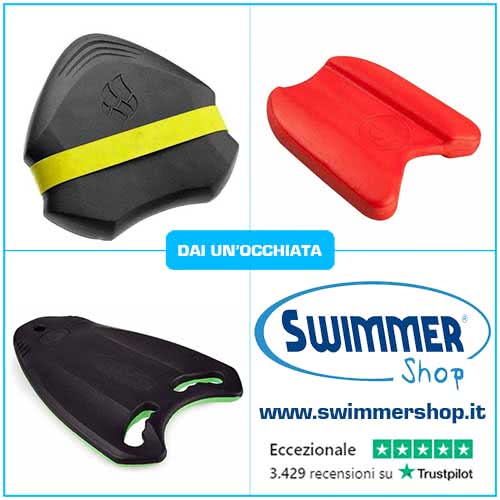Come scegliere la tavoletta
Perché "come scegliere la tavoletta"? Una tavoletta può sembrare un attrezzo piuttosto semplice. Un pezzo rettangolare di schiuma semirigida galleggiante che aiuta i nuotatori a isolare il lavoro di gambe e aumentarne la resistenza. Ciononostante ci sono innumerevoli forme e modelli di tavolette, ognuna con i propri pro e contro.
In questo post vorrei brevmente spiegare quali sono i diversi tipi di tavolette e per cosa sono progettati (senza essere esaustivo! Chissà quante ne verranno fuori di nuove prima che io abbia finito di scrivere questo articolo...)

Tavolette tradizionali
Le tavolette tradizionali di solito sono spesse, ad alto coefficiente di galleggiamento e piuttosto rigide. Rettangolari nella forma con la parte frontale leggermente curva e spesso concava la parte opposta.
Utilizzabili da nuotatori di tutti i livelli di abilità. Sono le più economiche e quelle che ti capiterà di vedere più spesso nelle piscine di tutto il mondo. Ma, proprio a causa del loro galleggiamento, spesso sono le tavolette di cui i nuotatori si lamentano maggiormente. Dopo un uso prolungato danno fastidi alle spalle e al collo e tendono a modificare l'assetto ideale del corpo durante la nuotata.
Tavolette ergonomiche
Le tavolette ergonomiche hanno la stessa funzione delle tradizionali ma sovraccaricano meno le spalle. In schiuma più leggera e, di solito, più piccole. Di forma triangolare (quindi idrodinamica) tendono a offrire meno resistenza all'acqua. La forma ergonomica spesso prevede fori per le mani alla base o una qualche forma di grip. una delle più conosciute è la tavoletta UPWAVE. Più costose delle tavolette tradizionali, di solito vengono utilizzate da chi si allena più di frequente e da chi ha (o vuole prevenire) problemi all'articolazione delle spalle.
Forse la migliore è la tavoletta da allineamento, più leggera delle normali tavolette ergonomiche, affonda un poco per dare alle spalle e alla testa l'assetto migliore durante la battuta di gambe. Inoltre è fornite, invece che di maniglie, di un elastico sotto al quale si possono infilare le mani.
Tavolette per Bambini
Le tavolette per bambini sono più leggere e più piccole di quelle per adulti. Progettate per essere impugnate con maggiore facilità le rende ideali anche per i nuotatori principianti. Colori accesi e disegni divertenti sono spesso il tratto distintivo di queste tavolette, puro divertimento da piscina. La leggerissima tavoletta COMFY fa parte di questa categoria (dai un'occhiata a fondo pagina, è quella color arcobaleno).
Tavolette/pullbuoy
Conosciute anche come "pull-kick" le combinazioni tavoletta/pullbuoy di solito hanno una sezione piatta al centro e due più "gonfie" e arrotondate ai lati così da poter essere sia impugnate come una tavoletta leggera sia messi tra le gambe come un pull-buoy. Il vantaggio principale è innanzitutto di avere un attrezzo in meno da portarsi dietro. Ancora una volta c'è un attrezzo all'avanguardia: il pullbuoy PullKick che può essere utilizzato sia come pull buoy che come tavoletta.
Le tavolette sono universali
Nonostante esistano tavolette di ogni forma e dimensione, si può dire che siano universali. Nel senso che un nuotatore adulto, se la trova più adatta a sé, può anche usare una tavoletta da bambino e viceversa. Nonostante sia una buona idea comprare una tavoletta adeguata alle proprie esigenze — come un'ergonomica se hai problemi alle spalle o un pull-kick se non ti vuoi caricare di troppi attrezzi ingombranti — le tavolette sono davvero universali una volta che ti trovi faccia a faccia con loro in acqua!
A kickboard seems like a straightforward piece of swim gear: A generally rectangular piece of foam that helps swimmers isolate their kick and increase leg endurance. However, kickboards come in many shapes and styles, each with its own benefits. This guide explains the various types of kickboards and what they're designed to do. Traditional Adult Kickboards Kickboards for adults are generally thick, highly buoyant, and rigid. Traditional kickboards are rectangular, with a slightly rounded front and concave bottom, and can be used by adult swimmers of all abilities. Because these are the most affordable kickboards, they are a common sight at swimming pools around the world. However, because of their buoyancy some swimmers complain of shoulder pain after long periods of use. Ergonomic & Streamlined Kickboards Ergonomic kickboards perform the same function as traditional kickboards, but put less strain on the shoulders. Made with lighter foam and a more triangular (and therefore hydrodynamic) shape, ergonomic kickboards move through the water with less resistance and put less pressure on shoulders. They also often have cutout handles at the bottom for easier head-down kicking. More expensive than standard kickboards, these streamlined versions are usually used by either advanced swimmers or those with shoulder issues. Children's Kickboards Children's kickboards are lighter and smaller than adult kickboards. They are designed to be easy to grip, which makes them easier for beginning swimmers to handle. Bright colors and graphics usually decorate these boards to encourage fun in the water. Kickboard-Pull Buoy Combos Also known by some brands as a "pull-kicks," the combination kickboard-pull buoy is a foam board that features a flat middle section between two slightly rounded side panels. This way, the two-in-one piece of equipment can be held out in front as a kickboard or between the legs as a pull buoy. The main benefit of the pull-kick is that it reduces the amount of gear swimmers need to carry with them, making pull-kicks ideal while traveling. Kickboards are a Universal Fit While kickboards do come in a variety of shapes and sizes, any swimmer can use any style of kickboard. Adults can use boards designed for children, just as children can quite easily — and often do — use adult-sized kickboards. While it's a good idea to buy the board that best meets your needs — like an ergonomic board for swimmers with shoulder problems, or a pull-kick for swimmers who hate lugging around lots of gear — kickboards really are one-size-fits-all pieces of equipment once they're in the water.
Read more at:
https://www.swimoutlet.com/guides/how-to-choose-a-kickboardA kickboard seems like a straightforward piece of swim gear: A generally rectangular piece of foam that helps swimmers isolate their kick and increase leg endurance. However, kickboards come in many shapes and styles, each with its own benefits. This guide explains the various types of kickboards and what they're designed to do. Traditional Adult Kickboards Kickboards for adults are generally thick, highly buoyant, and rigid. Traditional kickboards are rectangular, with a slightly rounded front and concave bottom, and can be used by adult swimmers of all abilities. Because these are the most affordable kickboards, they are a common sight at swimming pools around the world. However, because of their buoyancy some swimmers complain of shoulder pain after long periods of use. Ergonomic & Streamlined Kickboards Ergonomic kickboards perform the same function as traditional kickboards, but put less strain on the shoulders. Made with lighter foam and a more triangular (and therefore hydrodynamic) shape, ergonomic kickboards move through the water with less resistance and put less pressure on shoulders. They also often have cutout handles at the bottom for easier head-down kicking. More expensive than standard kickboards, these streamlined versions are usually used by either advanced swimmers or those with shoulder issues. Children's Kickboards Children's kickboards are lighter and smaller than adult kickboards. They are designed to be easy to grip, which makes them easier for beginning swimmers to handle. Bright colors and graphics usually decorate these boards to encourage fun in the water. Kickboard-Pull Buoy Combos Also known by some brands as a "pull-kicks," the combination kickboard-pull buoy is a foam board that features a flat middle section between two slightly rounded side panels. This way, the two-in-one piece of equipment can be held out in front as a kickboard or between the legs as a pull buoy. The main benefit of the pull-kick is that it reduces the amount of gear swimmers need to carry with them, making pull-kicks ideal while traveling. Kickboards are a Universal Fit While kickboards do come in a variety of shapes and sizes, any swimmer can use any style of kickboard. Adults can use boards designed for children, just as children can quite easily — and often do — use adult-sized kickboards. While it's a good idea to buy the board that best meets your needs — like an ergonomic board for swimmers with shoulder problems, or a pull-kick for swimmers who hate lugging around lots of gear — kickboards really are one-size-fits-all pieces of equipment once they're in the water.
Read more at:
https://www.swimoutlet.com/guides/how-to-choose-a-kickboard






 Il cuore della stabilità: stabilità del corpo nello Stile Libero
Il cuore della stabilità: stabilità del corpo nello Stile Libero  Perché la posizione della testa è cruciale nella respirazione a stile libero
Perché la posizione della testa è cruciale nella respirazione a stile libero  L'allungo nello stile libero
L'allungo nello stile libero  Migliorare lo Stile Libero per i Triatleti: Efficienza, Potenza e Resistenza
Migliorare lo Stile Libero per i Triatleti: Efficienza, Potenza e Resistenza  Nuovo slancio in acqua: come aumentare la velocità grazie alle pinne
Nuovo slancio in acqua: come aumentare la velocità grazie alle pinne  Storia del Nuoto
Storia del Nuoto  Mondo Nuoto Italia
Mondo Nuoto Italia  Allenamento
Allenamento  Livello Principiante
Livello Principiante  Livello Intermedio
Livello Intermedio  Livello Esperto
Livello Esperto  Esercizi di tecnica
Esercizi di tecnica  Notizie e novità
Notizie e novità  Teoria dell'allenamento
Teoria dell'allenamento